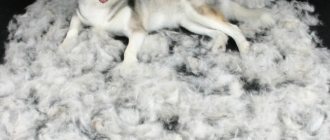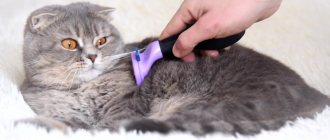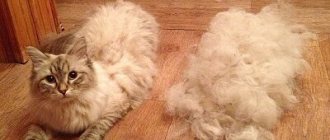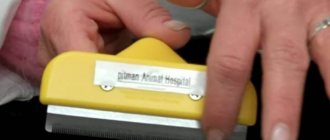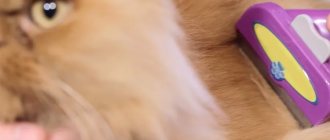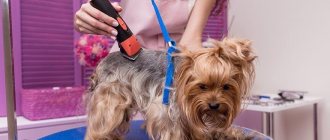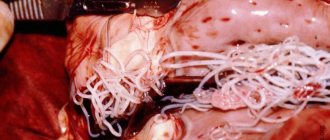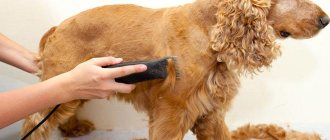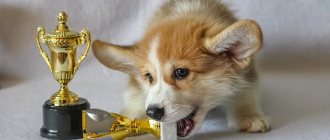Updated: 02/26/2021 13:54:58
Expert: Rudenko Irina Sergeevna
*Review of the best according to the editors of expertology.ru. About the selection criteria. This material is subjective in nature, does not constitute advertising and does not serve as a purchase guide. Before purchasing, consultation with a specialist is required.
To care for animal fur during the shedding period, it is worth purchasing a furminator. This tool allows you to safely comb out the hair and reduces the period of hair loss. Let's find out how to choose the right device for your pet, and which models are especially popular.
Furminator for dogs - what is it and how does it work
The Furminator is an improved comb for removing undercoat on dogs, cats, rabbits, and horses. The tool was invented by American groomers Angie and David Porter. In 2000, they patented the FURminator deShedding trademark and launched production in China.
Now other companies are creating furminator combs. The FURminator brand name has evolved into the name of a tool for manually removing loose hair from pets.
Externally, the furminator resembles a razor, but instead of blades, a comb is attached to the handle. The teeth along their length are covered with excisions invisible to the eye, and are rounded at the tips. The distance between them is strictly adjusted so that the guard hair can pass freely.
When combing, the comb catches dead hair and lifts it to the surface without cutting or tugging. “Living” guard and integumentary hair slips between the teeth and remains intact.
Furminator in detail
Contrary to the obvious analogy with a razor, the furminator functions somewhat differently. Its main difference is greater security. The blade is located at an angle at which it is almost impossible to injure the animal when combing.
In terms of the degree of danger, a furminator is no different from a brush
Formally, the Furminator does not bring anything new to the market of all kinds of combs for cats. Its main advantages are its ergonomics and ease of use, which allow this tool to outperform its competitors.
The amount of dead fur that pets carry around for months is astonishing.
It's no secret that pets without proper care can accumulate lost hair, which in worst cases forms tangles. Located in the deep layers of the wool, it does not have the ability to “fall out” on its own. The furminator blade, made of strong steel, allows you to rid your pet of this dead, falling out undercoat.
Thanks to its well-thought-out design, the furminator does not cause pain to the cat.
The guard hairs, the plucking of which can be very painful, remain untouched when combing. Therefore, there is no need to worry about your pet’s sudden sharp reaction to the procedure.
Important! The Furminator should not be treated as a magic wand. Remember that no device can get rid of loose hair in the house once and for all. Reducing the amount of wool and preventing tangles are the main goals of the furminator.
It is worth noting that if the pet initially has problems with the quality of its coat, then the Furminator will not be able to help it. Read on to learn about vitamin complexes that will help improve your cat’s metabolism and restore its fur.
Vitamins against brittle cat hair
Advantages and disadvantages
With a regular comb it is difficult to reach the undercoat and remove it completely; the slicker scratches the skin and tears the living hair. The Furminator clearly wins over traditional instruments:
- Removes lifeless fur faster.
- Captures the undercoat deeper and completely removes already fallen hair.
- Reduces seasonal molting time by 2 times.
- Does not cause pain, does not leave scratches.
- Massages the skin.
- It does not tear the guard hair, and after treatment the coat looks healthy and neat.
- Evenly distributes fatty lubricant, which moisturizes the skin and forms a protective film on the surface.
- Prevents tangles from forming.
- During shedding, the house looks cleaner and tidier.
Furminators have only 2 drawbacks. They cost more than regular combs and brushes and are not suitable for all coat types. The price of furminators is from 900 to 3000 rubles.
Reviews of furminators
I bought it for myself because it was unrealistic to have a new family member. A regular scratcher didn't help. Furminator is really better. It combs out a lot. True, not everything, as practice shows (but this could also be because I comb it out unsystematically, and when I get around to it, once every two or three days). But the house is becoming cleaner. I bought it in a small size, near the house, in an ordinary zoo basement, it cost 1200 rubles. To achieve maximum effect, after scratching I also collect all the remains from the cat with wet hands. Now BUT: they say that not all animals tolerate this easily, mine is usually scratched together, to achieve the best result. But overall, I recommend it.
Piccolina
https:///showthread.php?t=124021
I used a furminator. On a Persian cat and a short-haired nobleman. They both liked it, although they didn’t like to itch very much, but here they purred and in general the fur didn’t fly for a couple of weeks.
Niflheim
https:///showthread.php?t=124021
Mom gave me and my cats just a super gift. Furminator. If anyone doesn’t know, this is a brush for combing out the undercoat. This pleasure costs about 2 thousand rubles (if you take good quality), but believe me, it’s worth it! Finally, the problem of shedding has been solved, especially for short-haired animals that cannot be combed with ordinary brushes. What’s most chic is that the furminator does not damage the skin or guard hairs, cats are simply delighted with it! Yes Yes! My cats, who faint at the sight of a brush, now follow me with their tails so that I can scratch them again. The grooming process is now accompanied by loud purring and rolling eyes with pleasure. I’m generally silent about the effect of combing. if you scratch for a long time, you can comb out the entire undercoat (it’s convenient for summer, but now I don’t want to work hard), so the furniture, floors and clothes will now not be so woolly.
DeepEyes
https:///forum/?tid=15&tem=323181
for the fur Cat breeds of all cats Aporods of Maine Kund cats for cats of the Maine Coon breed Description of the cat breed Peculiarities of the breed in
dogskunymineshampoofeedarticlesandhelpmonthsownersforever
How to choose a Furminator for a dog
Before purchasing, consider the details of the tool:
- The size of the teeth, the distance between them. The Furminator will comb out the undercoat well if the length and frequency of the teeth correspond to the animal’s coat. Too many short teeth will not reach the undercoat of long-haired, fluffy dogs. Rare long ones will not capture dead hair in short-haired animals.
- Quality of the working surface. In good quality instruments, the comb is made of durable stainless alloy. Upon examination, the teeth are even, shiny, smooth, without scratches, gaps or irregularities. To check, run the comb over your head. A good comb allows the hair to slide freely, leaving only traces of dust on the teeth.
- Ridge width. Estimate the size of the dog, weigh the pet. Mentally imagine which comb will remove the undercoat faster and more thoroughly. A miniature comb 3.5 cm wide will take more than an hour to treat a large dog. Wide combs 10–12 cm are inconvenient for combing small animals. For giant and large dogs, it is better to use two combs: a wide one for processing the body, a medium one for bends, paws, and head.
- Ergonomic handle. The comb with a textured rubber insert and a convex end on the handle does not slip out of the palm. For the rest, look at how you feel: how comfortable the instrument fits in your palm. The hand will quickly get tired if the length or width is not suitable, the tool is too heavy or constantly pops out.
- Fur reset button. This addition speeds up combing, but weakens the structure. Simple models are more durable, and hair is not difficult to remove with your hands.
- Additional functions. Manufacturers are constantly improving tools. They produce models with removable combs and sets of attachments of different widths, lengths and frequencies of teeth. Such tools are convenient to use when there are several animals of different sizes in the house. However, classic monolithic combs with bolted combs work longer.
New models have a vibration massage system built into them and are battery-powered. The animal may not like this at all. The moving and buzzing sounds are frightening and unnerving. The recommendations listed will be useful in a regular pet store, when you can pick up the comb and examine it. Order online from websites with a detailed description of what size and coat length dogs the furminator comb is suitable for. Read reviews on forums.
Where can I buy?
In addition to the fact that Furminators are sold in most pet stores, they can easily be ordered on the Internet. Many trading platforms offer a periodically updated range of furminators, ranging from the original to fakes for 500 rubles. Cheap analogues can be found in any Chinese online store.
An important criterion when choosing a furminator is its comfortable position in the hand.
As already mentioned, it’s up to you to work with the furminator, so it’s better to choose it in person. Hands, like attachments, are different, and a mistake with the choice will leave an imprint on all subsequent procedures.
How to use a furminator
Before treatment, inspect your dog's skin. The procedure will have to be postponed if you see inflammation or rashes. For single scratches and small wounds, you can comb out, but do not touch the damaged areas.
After examination, treat your pet in order:
- Straighten tangled hair with a regular comb. For long-haired animals, separate the tangles with your hands or remove them with a tangle cutter. The Furminator can't handle them.
- Bathe your dog with pet shampoo and dry thoroughly. The comb tears the wet hair. Do not treat unwashed wool either; particles of dirt and dust clog the notches on the teeth, making them dull faster.
- Sit, stand or lay the dog down, as the animal prefers. Move during processing.
- Brush only according to the growth of the fur with confident movements without pressure. Go through one place no more than 2 - 3 times, every 40 - 60 seconds remove the hair from the teeth.
- For dogs with short to medium hair, first go along the back from head to tail, then move to the sides, moving from the spine to the paws.
- Treat long-haired dogs in sections. First, lift the fur from one side and comb out the undercoat below the belly. Then release some of the hair and repeat the treatment on the area above. Gradually work your way up to your back, finally walking along the spine from neck to tail. After processing one side, move on to the other.
- Gently brush areas that dogs don't like to touch: areas on the head, belly, tail, paws, back of the thighs.
- After treatment, rinse the instrument with warm soapy water and dry. Do not wipe the comb with napkins, so as not to disturb the sharpening. Combing takes from 15 minutes to 1 hour depending on the size of the dog and the thickness of the undercoat.
During shedding, the old undercoat is usually removed after 4 to 5 treatments. The rest of the time, comb long-haired dogs once every 10-14 days, remove excess hair at the beginning of summer so that the animal does not suffer from the heat. Treat short-haired dogs once a month. “Apartment” dogs often shed all year round and are brushed every week.
Features of training a Maine Coon to comb
These cats begin to shed from childhood, when their baby fur changes to adult fur.
That is why it is necessary to accustom a Maine Coon to combing from childhood, so that the kitten learns that this is a necessary procedure and then does not have to figure out how to comb out the Maine Coon’s tangles.
Usually the first shedding begins when the kitten is about six months old or a little older, and can continue even until he is two years old.
This is a normal and natural process, but it means that now you will have to brush it at least once a week.
For those who want to know how to brush a Maine Coon at home, it is important to remember that the kitten must be taught to perceive the process as pleasant.
At the initial stage, you should not hold him or use a hard brush, which may cause him pain.
Then the adult animal will know that it will be released, and will calmly react to the owner’s desire to comb it.
Normal seasonal shedding lasts from September to November, and then from February to April, but for indoor cats this schedule often gets disrupted.
In addition, one hair lives on them for no more than a month, which means they are constantly being replaced and renewed.
Your Maine Coon will have to be brushed constantly, so he should enjoy the process. Then you won’t have to decide how to comb your Maine Coon if he’s against it. It may be worth offering him a treat if you can't cope otherwise.
Another option is to use a special mitten so that the animal thinks that it is just being petted.
Maine Coon hair needs to be brushed constantly/Yandex Collections
What breeds of dogs need a Furminator and 4 types of fur that it will harm?
The Furminator is approved for dogs with long, moderate, short hair of medium hardness and thick undercoat:
- German, Belgian shepherds;
- labradors;
- husky;
- Rottweilers;
- pugs;
- dachshunds;
- likes;
- Newfoundland;
- beagles;
- spaniels;
- malamute;
- Spitz;
- chow-chow;
- setters;
- griffins;
- fox terriers;
- pinschers;
- St. Bernards;
- bobtails;
- collie;
- alabayam;
- English and French bulldogs.
The list goes on. The furminator harms certain types of wool:
- Long silky without undercoat - Maltese, Yorkshire terriers, Shih Tzu, Papillons, Phalenes, Lhasa Apso.
- Hard, dense, wavy: Irish and American water spaniel, schnauzers, terriers. The teeth trim the hard guard hair.
- Soft: Bichon Frize, Poodles, Bedlington Terrier, Soft Coated Wheaten Terrier. The comb combs out the guard hair that is too thin along with the undercoat.
- Twisted into dreadlocks: bullets, commander, Spanish water dog, havanese.
A furminator is not required for hairless dogs or dogs with short, fine hair: Peruvian and Mexican Hairless, Chinese Crested, Pharaoh, Italian Greyhounds, and American Hairless Terriers.
Principle of operation
It is not difficult to understand how a regular furminator for cats works; you just need to imagine a human trimmer. Only now he does not shave the cat, but only lifts the top layer of fur so that he can get to the undercoat. In this case, the wool is not cut or pulled out.
The special position of the teeth allows you to remove up to 90% of hair. But for this it will be necessary to carry out at least 3-4 procedures during the animal’s molting period.
Combing procedure
Original FURminator
The company produces furminators from durable stainless alloy, so the combs have been used for years. The handles do not deform, do not break, the teeth do not bend, the sharpness remains sharp for a long time, and the comb does not fall off. Manufacturers provide a 10-year warranty.
There is the right size for an animal of any size:
| Size | Ridge width, cm | Dog weight, kg |
| X-Small | 3 | up to 4 |
| Small | 4 | 4 – 9 |
| Medium | 7 | 9 – 23 |
| Large | 10 | 23 – 40 |
| X-Large | 13 | 40+ |
Combs marked Short hair are used for short-haired dogs with hair length less than 5 cm, and those marked Long hair are used for long-haired animals. In the first version, the teeth are slightly shorter. All FURminator models have a button to reset the combed hair.
Classic instruments with manual hair removal are no longer produced. In the new models, only the design has changed: the body has become more streamlined, the working surface remains the same.
Benefits of the new tool
But before buying such a tool for caring for an animal, you should know its advantages and why it is better than other combs and brushes.
Let's name just a few of them:
- Removes even dead undercoat from the very bottom. If the owner uses a regular comb, then only 70% of the fur is combed out, everything else remains in the undercoat, accumulates, and gets tangled;
- After such combing, the fur becomes noticeably silkier and healthier. When combing, the grease is distributed over all areas of the coat;
- The cat does not experience discomfort or pain. The wool does not come off. Hair removal can be done on sensitive areas of the skin;
- It will last a very long time and will pay for itself several times over;
- Reduces the number of tangles. You can see what the tangles look like in the photo;
- It combs out more hair and the cat stops choking on it;
- You can't ignore the cleanliness of your home. No brush can save you from the ubiquity of hair.
Rating of furminators of other brands
Dog owners often buy original FURminator combs, but other manufacturers also create good tools. Here are examples in descending order of popularity:
Trixie brush for dogs
Trixie. A German company produces comb-trimmers similar to furminators. Models differ in the width of the working surface: 3.5 cm, 6, 7, 8 and 11 cm. Steel ridges are removed at the touch of a button. Plastic handles are covered with anti-slip inserts. The mounts are the same for all models. One handle fits combs of any width. The total length of the handle with comb is 14 or 15 cm.
Hello Pet. The Taiwanese company creates furminators with a steel comb and a plastic body. On sale there are simple classic models with a wool cleansing button and double-sided models with a two-row comb and a comb for removing undercoat. The Hello Pet company produces 4 sizes - small, medium, large, super large. The combs differ in frequency, length, and number of teeth: from 25 to 97.
Hello Pet double-sided furminator for dogs.
Foolee. The French company produces combs in two categories: One and Easee. They work the same way, but Foolee Easee has additional features. The wool is shed by pressing a button, the switch adjusts the height of the teeth to the length of the wool. The set includes 2 combs: black for intensive combing, white for gentle care.
Furminators FoOlee.
The company produces combs in 10 shades, 5 sizes:
| Size | Ridge width, cm | Dog weight, kg |
| XS | 3,1 | Up to 5 |
| S | 4,5 | 5 – 10 |
| M | 6,5 | 10 – 25 |
| L | 10 | 25 – 40 |
| XL | 13 | 40+ |
Vivog. The French company produces classic furminators and rotary ones with two working surfaces. In the second option, one wide-toothed comb straightens tangled hair and removes small tangles. Another working surface with fine teeth is used directly for combing out the undercoat.
Furminator Vivog.
Kudi. Furminators from Chinese manufacturers are cheaper than others, but are not much inferior in quality. In classic models, the comb is screwed on, the handles are covered with rubber grooved inserts. 2 in 1 combs are available with two working surfaces: one with sparse teeth, the other with frequent teeth. They change by turning the roller.
Furminator Kudi with two working surfaces.
How to choose tool size?
The choice of comb width depends on the size of the cat:
- 3.2 cm - suitable for medium-sized kittens aged 2-3 months;
- 4.5 cm - for adult pets of small breeds whose weight is not more than 5 kg - Siamese, Balinese, mongrel;
- 6.8 cm - for cats of large breeds weighing more than 5 kg - Siberian, Angora, Maine Coon and others, as well as outbred cats, which delight the owners with a large article.
It is important to choose the right size. You should not buy a comb “for growth” and try to comb an animal weighing 2 kg with a tool for large animals. Significant areas of the body will remain untreated. If you use a furminator for kittens for an adult cat, the duration of the combing process will increase several times, and the efficiency will decrease.
